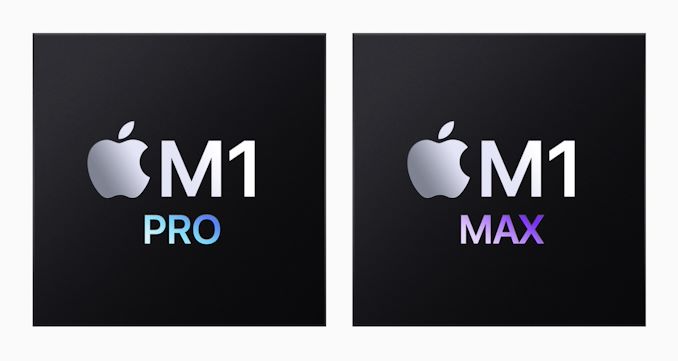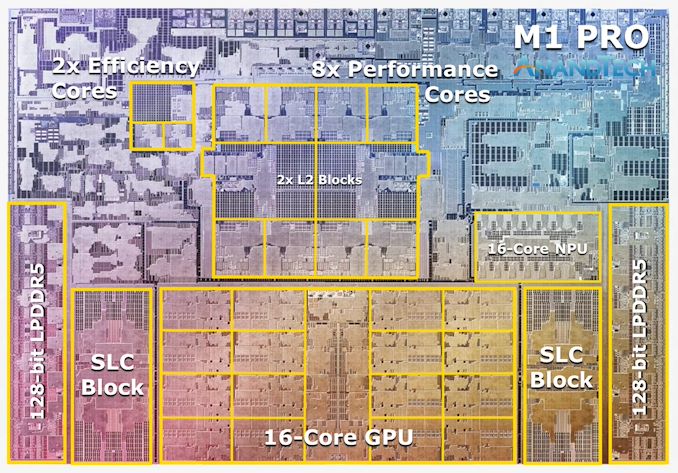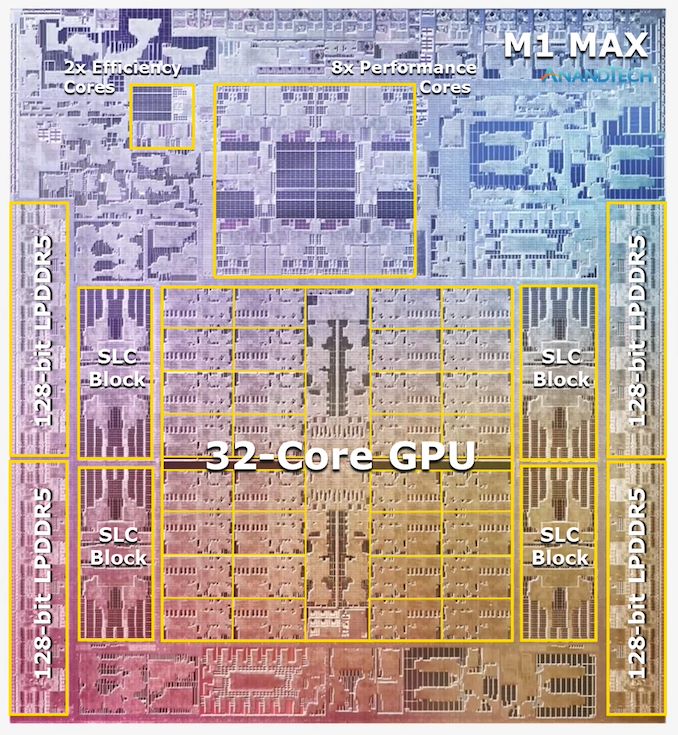Apple's M1 Pro, M1 Max SoCs Investigated: New Performance and Efficiency Heights
by Andrei Frumusanu on October 25, 2021 9:00 AM EST- Posted in
- Laptops
- Apple
- MacBook
- Apple M1 Pro
- Apple M1 Max

Last week, Apple had unveiled their new generation MacBook Pro laptop series, a new range of flagship devices that bring with them significant updates to the company’s professional and power-user oriented user-base. The new devices particularly differentiate themselves in that they’re now powered by two new additional entries in Apple’s own silicon line-up, the M1 Pro and the M1 Max. We’ve covered the initial reveal in last week’s overview article of the two new chips, and today we’re getting the first glimpses of the performance we’re expected to see off the new silicon.
The M1 Pro: 10-core CPU, 16-core GPU, 33.7bn Transistors
Starting off with the M1 Pro, the smaller sibling of the two, the design appears to be a new implementation of the first generation M1 chip, but this time designed from the ground up to scale up larger and to more performance. The M1 Pro in our view is the more interesting of the two designs, as it offers mostly everything that power users will deem generationally important in terms of upgrades.
At the heart of the SoC we find a new 10-core CPU setup, in a 8+2 configuration, with there being 8 performance Firestorm cores and 2 efficiency Icestorm cores. We had indicated in our initial coverage that it appears that Apple’s new M1 Pro and Max chips is using a similar, if not the same generation CPU IP as on the M1, rather than updating things to the newer generation cores that are being used in the A15. We seemingly can confirm this, as we’re seeing no apparent changes in the cores compared to what we’ve discovered on the M1 chips.
The CPU cores clock up to 3228MHz peak, however vary in frequency depending on how many cores are active within a cluster, clocking down to 3132 at 2, and 3036 MHz at 3 and 4 cores active. I say “per cluster”, because the 8 performance cores in the M1 Pro and M1 Max are indeed consisting of two 4-core clusters, both with their own 12MB L2 caches, and each being able to clock their CPUs independently from each other, so it’s actually possible to have four active cores in one cluster at 3036MHz and one active core in the other cluster running at 3.23GHz.
The two E-cores in the system clock at up to 2064MHz, and as opposed to the M1, there’s only two of them this time around, however, Apple still gives them their full 4MB of L2 cache, same as on the M1 and A-derivative chips.
One large feature of both chips is their much-increased memory bandwidth and interfaces – the M1 Pro features 256-bit LPDDR5 memory at 6400MT/s speeds, corresponding to 204GB/s bandwidth. This is significantly higher than the M1 at 68GB/s, and also generally higher than competitor laptop platforms which still rely on 128-bit interfaces.
We’ve been able to identify the “SLC”, or system level cache as we call it, to be falling in at 24MB for the M1 Pro, and 48MB on the M1 Max, a bit smaller than what we initially speculated, but makes sense given the SRAM die area – representing a 50% increase over the per-block SLC on the M1.
The M1 Max: A 32-Core GPU Monstrosity at 57bn Transistors
Above the M1 Pro we have Apple’s second new M1 chip, the M1 Max. The M1 Max is essentially identical to the M1 Pro in terms of architecture and in many of its functional blocks – but what sets the Max apart is that Apple has equipped it with much larger GPU and media encode/decode complexes. Overall, Apple has doubled the number of GPU cores and media blocks, giving the M1 Max virtually twice the GPU and media performance.
The GPU and memory interfaces of the chip are by far the most differentiated aspects of the chip, instead of a 16-core GPU, Apple doubles things up to a 32-core unit. On the M1 Max which we tested for today, the GPU is running at up to 1296MHz - quite fast for what we consider mobile IP, but still significantly slower than what we’ve seen from the conventional PC and console space where GPUs now can run up to around 2.5GHz.
Apple also doubles up on the memory interfaces, using a whopping 512-bit wide LPDDR5 memory subsystem – unheard of in an SoC and even rare amongst historical discrete GPU designs. This gives the chip a massive 408GB/s of bandwidth – how this bandwidth is accessible to the various IP blocks on the chip is one of the things we’ll be investigating today.
The memory controller caches are at 48MB in this chip, allowing for theoretically amplified memory bandwidth for various SoC blocks as well as reducing off-chip DRAM traffic, thus also reducing power and energy usage of the chip.
Apple’s die shot of the M1 Max was a bit weird initially in that we weren’t sure if it actually represents physical reality – especially on the bottom part of the chip we had noted that there appears to be a doubled up NPU – something Apple doesn’t officially disclose. A doubled up media engine makes sense as that’s part of the features of the chip, however until we can get a third-party die shot to confirm that this is indeed how the chip looks like, we’ll refrain from speculating further in this regard.














493 Comments
View All Comments
Makaveli - Tuesday, October 26, 2021 - link
Sadly this is true have a majority of children and man children that just play games and really do nothing else on a PC and they think they drive the industry. You would expect to be getting more comments from people in the industry and IT professionals then the children come in with my games my fps I need more blah blah blah. You have less of this on anandtech compared to some other forums but you cannot escape it sadly. I'm not even a mac guy don't have a single apple device in my house but I know that no one is dropping that kinda coin apple wants for this to play games.itsmrfungible - Tuesday, October 26, 2021 - link
For 35+ years all we heard were “Macs are toys, get a real computer” then once Macs start beating Intel all we hear is “but muh games.” Who’s playing with toys now?ComputeGuru - Tuesday, October 26, 2021 - link
Intel isn't even the leader in the PC market anymore. Intel has become largely irrelevant due to their own stupidity.valuearb - Tuesday, October 26, 2021 - link
The biggest gaming market in the world by dollars is iOS.ComputeGuru - Tuesday, October 26, 2021 - link
We're talking about desktop/Mac gaming. Keep up with the convo.photovirus - Wednesday, October 27, 2021 - link
It's actually relevant.iOS has a lot of common frameworks with macOS (especially now with Catalyst). Studios which are proficient in high-end mobile graphics might want to take one step beyond and make visuals for M1 iPads and Macs. Especially since they have money from the biggest gaming market.
With M1, Macs and iPads are ready for AAA-games, and also they sell well, so it's a good time to make some games for the platform.
I think we'll see an inflection point quite soon. Tens of millions of gaming-worthy hardware can't get unnoticed by the publishers. :~)
ComputeGuru - Tuesday, October 26, 2021 - link
Sure the mobile gaming market that comprises Android and iOS is bigger, there are also a lot more people with access to mobile phones that can run casual games than computers capable of gaming, so that's not a surprise. Since we're talking about Mac/Desktop gaming here not mobile this point is moot.ryne.andal - Monday, October 25, 2021 - link
I'm sold. It's precisely what I want out of a productivity machine. Plenty of horsepower for when there's a need to compile and develop locally, plenty of battery life for remote/ssh work as well.rmari - Monday, October 25, 2021 - link
In regard to bandwidth, the author is too disparaging.The CPU cores are maxed out in ability to use bandwidth at 243 GB/s.
But the author complained that they should be able to use all 400 GB.
However, all the memory bandwidth is shared across all the system components.
So if the GPU maxes out at 90 GB/s, the CPU+GPU Max bandwidth need is 333 GB/s.
This leaves 67 GB/s (about the bandwidth of the M1) for the rest of the components
including the Neural Processor and the Media Processors - which can encode and decode
multiple 8K videos simultaneously.
Obviously the massive bandwidth allows the M1 Max to minimize the CONTENTION
for memory resources used for Unified Memory.
If the CPU hogged all 400 GB/s bandwidth, then the GPU and the rest of the chip
couldn't function since they would have ZERO memory access.
Duh.
sirmo - Monday, October 25, 2021 - link
Nah it is clear Apple picked a oversized bus to save on power.